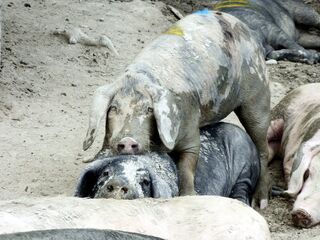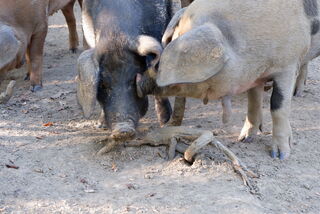Anger
Bystander Pigs Get Involved to Maintain Social Harmony
Pigs use different post-conflict strategies depending on who is fighting.
Posted November 8, 2022 Reviewed by Abigail Fagan
Key points
- Domestic pigs form complex social groups and engage in different post-conflict behaviors depending on the identity of the pigs involved.
- Distantly related pigs are more likely to reconcile after fighting than closely related pigs.
- Bystander pigs are more likely to intervene after a fight if they are closely related to the aggressor or victim.

When living in a social group, it pays to keep the peace. Conflict resolution is an important aspect of the social lives of many animals, human and otherwise, and it can take a couple forms.
The former opponents (the aggressor and the victim) may reunite and make up after a conflict. This is known as reconciliation.
Alternatively, a third-party bystander may intervene to reduce further aggression or anxiety. This may be solicited by either the victim or the aggressor, or spontaneously initiated by the bystander.
These conflict resolution strategies, which help maintain balance in social groups, have been well studied in some animals, such as apes. But what about domestic pigs?
Acting Piggy
In a new study, Giada Cordoni, Ivan Norscia, and colleagues from the University of Torino in Turin, Italy investigated how a group of 104 pigs housed at the ethical farm Parva Dormus resolves conflict after fighting.
Cordoni says that pigs have the required social and cognitive skills for conflict resolution.
“The domestic pig is a highly social and cognitively advanced species that is able to discriminate familiar individuals and objects, shows sensitivity to the internal states of others, and proactively responds to others’ distress,” she says.

Cordoni and colleagues observed and recorded interactions between the pigs for six months. The researchers say that conflicts between pigs are usually short in duration, though they represent perturbing events for the entire group. Aggressive behaviors include chasing, mounting, biting, pushing with the nose or body, kicking, and head-knocking. Conflict resolution behaviors observed immediately afterward involve making nose or body contact with another pig.
Sensitive Swine
Cordoni and colleagues report that the pigs in this group engaged in both reconciliation and third-party contacts after conflicts. Interestingly, relatedness affected these two post-conflict strategies in different ways.
The researchers found that aggressors and victims were equally likely to initiate reconciliation after fighting—but reconciliation occurred more frequently between more distantly related pigs (i.e., cousins) than closely related ones (i.e., siblings or mother-offspring). The researchers suggest that the social relationships between more distantly related pigs are less secure than those between close relatives and therefore require more making up after a fight.

On the contrary, third-party interventions occurred more frequently in pigs closely related to those in a fight. But Cordoni and colleagues noted differences depending on who the bystander pig approached and engaged with after the fight. When a bystander initiated contact with a victim of aggression, the victim’s anxiety was reduced. When a bystander initiated contact with an aggressor, further aggression toward the victim was limited.
Since bystander pigs were more likely to intervene if a conflict involved a closely related pig, the researchers suggest that pigs value certain relationships and may support their close relatives.
“The fact that all the post-conflict strategies were skewed by kinship and that the function of third-party unsolicited contacts (anxiety reduction and limited aggression) depended on the contacted individual once more highlight the complex cognitive abilities of the domestic pig,” says Cordoni. “Moreover, our results suggest pigs are capable of socio-emotional regulation and social appraisal.”
Overall, Cordoni says their findings add to the evidence that pigs and humans share similar behavioral strategies for coping with social challenges—when given the opportunity.
“When domestic pigs are reared under semi-natural conditions, they can freely express their entire behavioral repertoire and naturally interact with one another,” she says. “This certainly increases the welfare of domestic animals.”
References
Cordoni, G., Comin, M., Collarini, E., Robino, C., Chierto, E., and Norscia, I. Domestic pigs (Sus scrofa) engage in non-random post-conflict affiliation with third parties: cognitive and functional implications. Anim Cogn (2022). https://doi.org/10.1007/s10071-022-01688-4.


